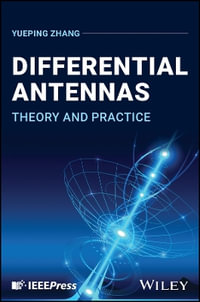| Preface | p. xiii |
| Introduction | p. 1 |
| Selected Numerical Methods | p. 9 |
| Mode-Matching Techniques | p. 9 |
| Introduction | p. 9 |
| Background | p. 10 |
| H-Plane Discontinuity | p. 12 |
| Normalization | p. 14 |
| Generalized Scattering Matrix | p. 15 |
| Relative Convergence | p. 16 |
| Discontinuity of Finite Length | p. 18 |
| Cascading Scattering Matrices | p. 19 |
| Intermediate Region | p. 20 |
| Waveguide Bifurcation | p. 20 |
| E-Plane Discontinuity | p. 25 |
| T-Junctions (Resonator Method) | p. 27 |
| E-Plane T-Junction | p. 27 |
| H-Plane T-Junction | p. 31 |
| Double-Plane Steps | p. 32 |
| TE[characters not producible] Mode Analysis | p. 33 |
| TE[subscript mn]-TM[subscript mn] Mode Analysis | p. 34 |
| Different Cross-Sections | p. 37 |
| Circular Cross-Section | p. 37 |
| Cross-Sections of Unknown Eigenfunctions | p. 39 |
| Other Mode-Matching Techniques | p. 40 |
| Conservation of Complex Power | p. 40 |
| Admittance Matrix Formulation | p. 40 |
| Appendix to Section 2.1 | p. 42 |
| References to Section 2.1 | p. 50 |
| Finite-Element Method | p. 51 |
| Introduction | p. 51 |
| Field Formulation | p. 52 |
| Variational Methods | p. 54 |
| Rayleigh-Ritz Method | p. 58 |
| Finite-Element Method | p. 59 |
| Two-dimensional Scalar Scattering Problem | p. 59 |
| Scattering Parameters | p. 63 |
| Infinite Elements | p. 63 |
| Uniform Guiding Structures | p. 63 |
| Characteristic Impedance | p. 66 |
| Summary of FEM Features | p. 67 |
| A FEM Computer Program for Multi-Conductor Lines | p. 68 |
| Acknowledgement | p. 68 |
| Appendix to Section 2.2 | p. 69 |
| References to Section 2.2 | p. 71 |
| The Transmission Line Matrix Method | p. 73 |
| Fundamentals of the TLM Method | p. 73 |
| Modeling Microwave Structures with the TLM Method | p. 76 |
| Modeling Boundaries | p. 76 |
| Modeling Ports | p. 77 |
| Modeling Materials | p. 78 |
| Regular versus Variable TLM Mesh | p. 79 |
| Time- and Frequency-Domain Information | p. 81 |
| Computation of Microwave S-Parameters | p. 81 |
| Errors and Corrections | p. 82 |
| Summary of the TLM Method | p. 82 |
| Application of the Three-Dimensional Symmetrical Condensed Node TLM Method to Computation of Microwave S-Parameters | p. 84 |
| Appendix to Section 2.3 | p. 86 |
| References to Section 2.3 | p. 101 |
| Waveguide Components for Antenna Feed Systems | p. 103 |
| Transmission Lines | p. 104 |
| Definitions | p. 104 |
| Electromagnetic Wave Modes (Eigenmodes, Eigenvectors) | p. 104 |
| Wave Propagating Media (Waveguides, Transmission Structures) | p. 105 |
| Propagation Constants (Wave Numbers, Eigenvalues) | p. 105 |
| Guided Wavelength | p. 106 |
| Dispersion Characteristics | p. 106 |
| Characteristic Impedance | p. 107 |
| Losses | p. 108 |
| Power Handling Capability | p. 108 |
| Rectangular Waveguides | p. 109 |
| Modes in Rectangular Waveguides | p. 110 |
| Fundamental Mode in Rectangular Waveguide | p. 112 |
| Mode Dispersion | p. 112 |
| Characteristic Impedance | p. 114 |
| Losses | p. 114 |
| Power Handling Capability | p. 115 |
| Ridge Waveguides | p. 115 |
| Modes in Ridge Waveguides | p. 116 |
| Dispersion Characteristics | p. 117 |
| Characteristic Impedance | p. 117 |
| Losses | p. 118 |
| Power Handling Capability | p. 120 |
| Circular Waveguides | p. 120 |
| Modes in Circular Waveguides | p. 121 |
| Dispersion Characteristics | p. 124 |
| Characteristic Impedance | p. 124 |
| Losses | p. 124 |
| Power Handling Capability | p. 126 |
| Coaxial Waveguides | p. 127 |
| Circular Coaxial Lines | p. 127 |
| Modes in Circular Coaxial Lines | p. 127 |
| Fundamental (TEM) Mode in Coaxial Waveguide | p. 130 |
| Dispersion Characteristics of the Coaxial Waveguide | p. 130 |
| Characteristic Impedance | p. 130 |
| Losses | p. 131 |
| Power Handling Capability | p. 132 |
| Square (Rectangular) Coaxial Waveguides | p. 133 |
| Modes in Square Coaxial Line | p. 133 |
| Dispersion Characteristics | p. 134 |
| Characteristic Impedance | p. 136 |
| Losses | p. 137 |
| Power Handling Capability | p. 138 |
| References to Section 3.1 | p. 139 |
| Impedance Transformers and Matching Circuits | p. 139 |
| Impedance-Matching Concepts and Methods | p. 140 |
| Matching a Real Impedance to Another Real Impedance | p. 142 |
| Matching a Real to a Complex Impedance | p. 145 |
| Matching With a Section of Transmission Line and a Quarter-Wave Transformer | p. 145 |
| Single Stub Matching | p. 146 |
| Double-Stub Matching | p. 147 |
| Practical Impedance Transformers--Design Methods and Examples | p. 148 |
| Impedance Transformers in Rectangular (Square) Waveguides | p. 148 |
| Rectangular-to-Ridge Waveguide Impedance Transformer | p. 151 |
| Circular Waveguide Transformers | p. 154 |
| Stepped Dielectric Slab Transformers | p. 157 |
| Appendix to Section 3.2 | p. 160 |
| References to Section 3.2 | p. 162 |
| Waveguide Bends | p. 163 |
| Field Analysis of Waveguide Bends | p. 165 |
| Design of Waveguide Bends | p. 165 |
| H-Plane Bends | p. 166 |
| E-Plane Bends | p. 169 |
| References to Section 3.3 | p. 174 |
| Microwave Filters | p. 174 |
| A Summary of Development in Theory and Design Methods for Microwave Filters | p. 174 |
| A Generalized CAD Method for Microwave Filters | p. 176 |
| Performance Parameters of a Microwave Filter | p. 176 |
| Synthesis | p. 177 |
| Analysis | p. 183 |
| Optimization | p. 184 |
| CAD of Selected Types of Direct-Coupled-Resonator Filters | p. 185 |
| Waveguide Stub Filters | p. 185 |
| E-Plane Filters | p. 190 |
| Corrugated Waveguide Filters | p. 200 |
| Evanescent-Mode Waveguide Filters | p. 207 |
| Circular Cavity Filters | p. 212 |
| Synthesis of Filter Characteristics and Equivalent Circuits | p. 217 |
| Approximation of Filter Characteristics | p. 217 |
| Synthesis of Equivalent Circuits | p. 220 |
| Degenerate (Multimode) Cavity Design | p. 221 |
| Cavity Modes | p. 221 |
| Dual Mode Cavity Design | p. 224 |
| Triple and Quadruple Mode Cavity Design | p. 224 |
| Tuning and Coupling of Degenerate Cavity Modes | p. 225 |
| Filter Couplings--Design and Realization | p. 226 |
| Intercavity and Interface Couplings | p. 226 |
| Offset Slots and Anticoupling | p. 233 |
| Spurious Mode Control | p. 237 |
| Cavity Arrangement and Coupling Configurations | p. 237 |
| Cavity Filter Design Technology | p. 247 |
| References to Section 3.4 | p. 248 |
| Multiplexers | p. 252 |
| Circulator/Filter Chain | p. 252 |
| Directional Filter Multiplexing Approach | p. 259 |
| Manifold Multiplexing Technique | p. 264 |
| Millimeter-Wave Multiplexers | p. 278 |
| E-Plane T-Junction-type Diplexer | p. 283 |
| H-Plane T-Junction-type Diplexer | p. 289 |
| H-Plane Divider-type Diplexer | p. 293 |
| E-Plane Divider-type Multiplexers | p. 294 |
| E-H-Plane Divider-type Quadruplexer | p. 295 |
| H-Plane Branching-type Multiplexers | p. 296 |
| Other Configurations | p. 300 |
| Appendix to Section 3.5 | p. 304 |
| References to Section 3.5 | p. 306 |
| Directional Couplers | p. 307 |
| Introduction | p. 307 |
| Basic Coupler Sections and Mechanisms | p. 309 |
| Contra-Directional Couplers | p. 311 |
| Co-Directional Couplers | p. 312 |
| Small-Aperture Couplers | p. 314 |
| Quarter-Wave Transformer Prototype | p. 314 |
| Contra-Directional (TEM-Line) Couplers | p. 316 |
| Aperture Couplers | p. 320 |
| Analysis | p. 320 |
| Circular Apertures | p. 322 |
| Rectangular Apertures | p. 323 |
| Design | p. 325 |
| Branch-Guide Couplers | p. 329 |
| Conclusions | p. 339 |
| Appendix to Section 3.6 | p. 340 |
| References to Section 3.6 | p. 342 |
| Power Dividers and Combiners | p. 343 |
| Introduction | p. 343 |
| Basic Waveguide Power Dividers/Combiners | p. 345 |
| Waveguide E-Plane Power Dividers/Combiners | p. 346 |
| Waveguide H-Plane Power Divider/Combiner | p. 351 |
| Waveguide E-H-Plane Power Divider/Combiner | p. 353 |
| Other Waveguide E- or H-Plane Power Dividers | p. 354 |
| Radial Waveguide Power Dividers/Combiners | p. 355 |
| Hybrids as Power Dividers/Combiners | p. 360 |
| Hybrid (Magic) T-Junction | p. 360 |
| Turnstile Junction | p. 361 |
| Hybrid Rings | p. 362 |
| Variable Power Dividers/Combiners | p. 363 |
| Considerations for Power Combiners | p. 367 |
| References to Section 3.7 | p. 369 |
| Polarization Discrimination Components and Equipment | p. 371 |
| Linear and Circular Polarizations | p. 372 |
| Linear Polarization | p. 372 |
| Circular Polarization | p. 374 |
| Orthomode Transducer | p. 377 |
| Standard Narrowband OMT Design (OMT Class 1) | p. 382 |
| Narrowband Design Type 1 (Taper/Branching OMT) | p. 382 |
| Narrowband Deisgn Type 2 (Septum/Branching OMT) | p. 385 |
| Narrowband Design Type 3 (Acute Angle or Longitudinal Orthomode Branching) | p. 391 |
| Narrowband Design Type 4 (Short Circuited Common Waveguide) | p. 393 |
| Broadband OMT Design (OMT Class 2) | p. 395 |
| Broadband OMT Design Type 1 (Distinct Dual Junction Type) | p. 397 |
| Broadband OMT Design Type 2 (Equal Dual Junction Type) | p. 400 |
| Four (Multi) Port Combiner (OMT Class 3) | p. 403 |
| Combiner Design Type 1 (Modular Approach) | p. 404 |
| Combiner Design Type 2 (Unsymmetrical Branching Approach) | p. 405 |
| Combiner Design Type 3 (Symmetrical Branching Approach) | p. 413 |
| Circular Polarizing and Discrimination Equipment | p. 418 |
| Conventional Polarizers | p. 419 |
| Conventional Polarizers, Group 1 | p. 421 |
| Corrugated Waveguide Polarizers | p. 426 |
| Dielectric Slab Waveguide Polarizers | p. 428 |
| Conventional Polarizers, Group 2 (Septum Polarizer) | p. 432 |
| Polarization Discrimination by OMT and Power-Splitter | p. 435 |
| Circularly Polarized Four (Multi) Port Combiners | p. 436 |
| Four (Multi) Port Combiners with Polarizers | p. 438 |
| Circularly Polarized Four (Multi) Port Combiners with Proper RF Circuitries | p. 440 |
| References to Section 3.8 | p. 443 |
| Table of Contents provided by Syndetics. All Rights Reserved. |
























